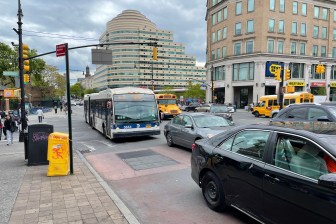Traffic: A Social Problem Not a Design Problem
 Before the commenters begin giving DOT its well-deserved pounding in response to my previous post, I offer this provocative excerpt from David Engwicht’s book, "Mental Speed Bumps: The Smarter Way to Tame Traffic."
Before the commenters begin giving DOT its well-deserved pounding in response to my previous post, I offer this provocative excerpt from David Engwicht’s book, "Mental Speed Bumps: The Smarter Way to Tame Traffic."
Let me be frank. Traffic is first and foremost a community problem and residents have no right expecting politicians, engineers and planning professionals to fix it for them. Hold on to your hats. I will have something to say to the politicians engineers and planning professionals in a moment.
I have worked in neighborhood after neighborhood where residents were asking the city to spend large sums of money to slow down one of their neighbors. I once chaired a meeting of residents that were asking the city to spend $250,000 to slow speeding motorists. When I asked how many motorists were causing the problem, an elderly gentleman said, "Five, and I can show you were everyone of them lives."
Asking your city to spend lots of money on forcing you and your neighbors to drive slower and less often seems like a huge waste of your hard-earned cash — especially when you could have the same result, at absolutely no cost, by simply shaking hands with your neighbor and agreeing that you will all act like guests in each other’s neighborhoods. The solution to traffic problems in neighborhoods is not more speed bumps. The solution is an outbreak of civility that slows our rampant individualism. And that is a cultural challenge, not a physical design challenge.





